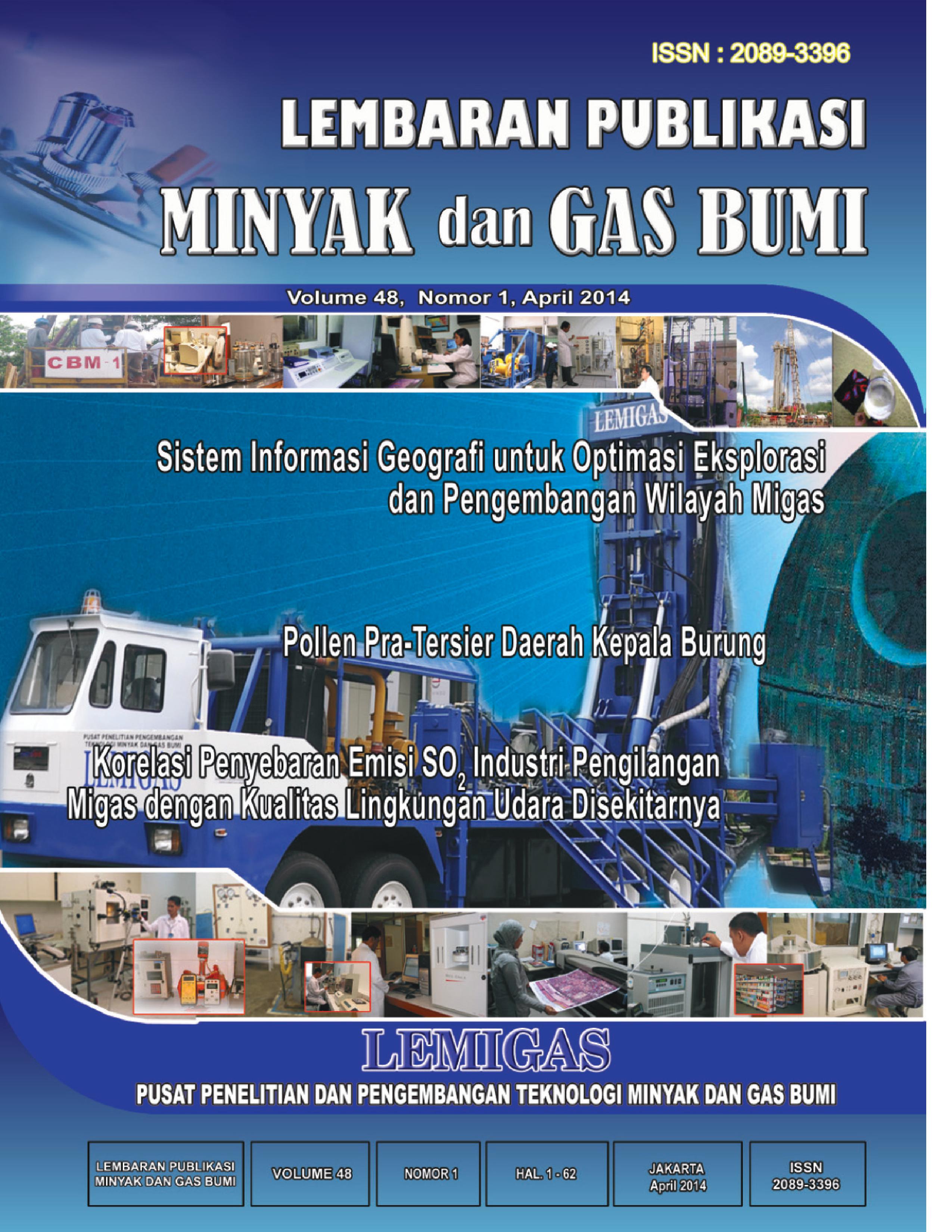Reduksi Gas CO2 oleh Mikroalga Scenedesmus sp. pada Fotobioreaktor Tertutup dengan Variasi Konsentrasi Gas CO2
DOI:
https://doi.org/10.29017/LPMGB.48.1.230Kata Kunci:
otobioreaktor, mikroalga, gas CO2, Scenedesmus spAbstrak
Salah satu metode potensial yang dapat digunakan untuk reduksi CO2 adalah memanfaatkan aktivitas mikroalga melalui proses fotosintesis. Mikroalga adalah bioagen yang mampu menangkap CO2 dan mengubahnya menjadi karbohidrat untuk menambah pertumbuhan populasinya. Banyaknya CO2 yang digunakan dapat mencapai hampir dua kali lipat dari berat kering biomassa yang dihasilkan. Tujuan kegiatan ini adalah mengkaji kemampuan mikroalga Scenedesmus sp dalam mereduksi gas CO2 pada suatu fotobioreaktor skala pilot dengan memvariasikan konsentrasi gas CO2 yang diinjeksikan ke dalam sistem. Penelitian dilakukan di Lapangan Gas Subang selama tujuh hari. Komposisi gas CO2 yang digunakan adalah ±98%. Sistem operasi adalah sistem batch dan media pertumbuhan yang digunakan adalah media “Sederhana 2”. Pada penelitian ini digunakan empat rangkaian fotobioreaktor dengan volume operasi masing-masing adalah 60 Liter. Masing-masing fotobioreaktor divariasikan perbandingan jumlah gas CO2 dan udara yang diinjeksikan, yaitu 0:100% (fotobioreaktor 1) yang berfungsi sebagai kontrol, 10:90% (fotobioreaktor 2), 30:70% (fotobioreaktor 3) dan 50:50% (fotobioreaktor 4). Kepadatan sel, optical density (OD), pH, dan berat kering digunakan sebagai parameter pengujian. Hasil penelitian menunjukkan bahwa reduksi gas CO2 tertinggi terdapat pada fotobioreaktor 2 yang terjadi pada hari ke-3 operasi, yaitu sebesar 8,09x10-5 gram dengan nilai kepadatan sel 23,87 x 106 sel/mL. Dari hasil tersebut dapat disimpulkan bahwa penambahan 10% gas CO2 ke dalam fotobioreaktor dapat meningkatkan pertumbuhan mikroalga Scenedesmus sp.
One potential method that can be used for the reduction of CO2 is utilizing the microalgae activity through the process of photosynthesis. Microalgae is a bioagen that is able to capture the CO2 and convert it into carbohydrates for the growth of the population. The number of CO2 used can achieve almost double of the dry weight biomass produced. The purpose of this study is to assess the ability of Scenedesmus sp. microalgae in the reduction of CO2 gas at a pilot scale photobioreactor by varying the concentration of CO2 to be injected into the system. The research was done in Subang gas eld for seven days. The composition
of the CO2 gas was ±98%. The operating system was a batch system and used ”Sederhana 2”as a growth media. In this study we were using four sets of photobioreactor with their respective operating volume of 60 liters. Each photobioreactor has a different ratio of CO2 gas and air to be injected, that is 0: 100% (1st photobioreactor) that serves as the control, 10:90% (2nd photobioreactor), 30:70% (3rd photobioreactor) and 50:50% (4th photobioreactor). Cell density, optical density (OD), pH, and dry weight were used as test parameters. The result showed that the reduction of the highest CO2 gas contained on 2nd photobioreactor which occurs on the 3rd day of the operation, i.e. by 8.09x10-5 gram with cell density of 23.87 x 106 cell/ mL . From these results it can be concluded that the addition of CO2 into the photobioreactor can increase the growth of microalgae Scenedesmus sp.
Referensi
[AOAC] Association of Analytical Chemist Publisher, 1999, Official Methods of Analysis. 3rd edition. Washington DC: AOAC Publisher.
Abdulgani, N., Zuhdi Aguk, M.F & Sukesi., 2010,”Potensi Mikroalga Skeletoma costatum, Chlorella vulgaris, dan Spirulina platensis sebagai Bahan Baku Biodiesel”, Institut Teknologi Surabaya, Surabaya.
Chisti, Y., 2007, “Biodiesel from microalgae”, Biotechnology Advances 25:294-306.
Gardener, 1991, “Fisiologi Tanaman Budidaya”, UI Press, Jakarta.
Haryadi, M.M.S. 1979, “Pengantar Agronomi”, Gramedia, Jakarta.
Hoshida, H., Ohira T., Minematsu A., Akada R. & Nishizawa Y., 2005, “Accumulation of Eicosapentaenoic Acid in Nannochloropsis sp. In Response to Elevated CO2 Concentrations”, Applied Phycology. 17: 29-34.
Istiyanie, D., 2011, “Pemanfaatan Emisi CO2 dari PLTU Batubara dalam Pengolahan Limbah Cair Domestik Berbasis Mikroalga”, Magister Ilmu Lingkungan, Universitas Indonesia, Jakarta.
Juneja, A., Ceballos, R.M., & Murthy, S.G., 2013, “Effects of Environmental Factors and Nutrient Availability on the Biochemical Composition of Algae for Biofuels Production: A Review”, Energies. 6: 4607-4638.
Kawaroe, M., Prartono, T., Sunuddin, A., Wulan, S. D., & Agustine, D., 2010, “Mikroalga Potensi dan Pemanfaatannya untuk Produksi Bio Bahan Bakar”, IPB Press, Bogor.
Lavens, P. & Sorgeloos P. (eds)., 1996, “Manual on the Production and Use of Live Food for Aquaculture”, FAO Fisheries Technical Paper. No. 361, Food and Agriculture Organization of the United Nations, Rome.
Mata, T.M., Martins, A.A., & Caetano, S.N., 2010, “Microalgae for biodiesel production and other applications: A review”, Renewable and Sustainable Energy Reviews 14, p.217–232.
Mooney,1977, “Photosynthesis Plant Ecology”, Blackwell Science, London.
Olaizola, M., Bridges, T., Flores, S., Griswold, L., Morency, J., & Nakamura, T., 2004, “Microalgal Removal of CO2 from Flue Gases:CO2 Capture from a Coal Combuster”, Biotech. Bioproc. Eng., 8: 360-367.
Ono, E., & Cuello, J.L., 2010, “Selection of optimal microalgae species for CO2 sequestration”, The University of Arizona Department of Agricultural and Biosystems Engineering 403 Shantz Building Tucson, AZ 85721, U. S. A.
Prihantini, B.N., Damayanti, D., & Yuniati, R., 2007, “Pengaruh Konsentrasi Medium Ekstrak Tauge (MET) Terhadap Pertumbuhan Scenedesmus Isolat Subang”, Makara Sains, Vol 11, No.1:1-9.
Ras, M., Steyer, J., & Bernard, O., 2013, “Temperature effect on microalgae: a crucial factor for outdoor production”, Environmental Science and and Bio/ Technology 12, 2: 153-154.
Sasmita G.P, Wenten G.I., & Suantika G., 2004, “Pengembangan Teknologi Ultrafiltrasi Untuk Pemekatan Mikroalga”, Prosiding Seminar Nasional Rekayasa Kimia dan Proses, F-23, p.1-5.
Wijanarko, A., Dianursanti, Gozan, M., Andika, S.M.K., Widiastuti, P., Hermansyah, H., Witarto, A.B., Asami, K., Soemantojo, R.W., Ohtaguchi, K., & Song, S.K., 2006, ”Enhacement of carbondioxide ixation by alteration of illumination during Chlorella vulgaris Buitenzorg’s growth”, Biotechnology and Bioprocess Engineering, 11:484-488.
Wijanarko, A., Dianursanti, Valentino, Hermansyah, H., Gozan, M., Witarto, A.B., & Soemantojo, R.W., 2007, “Pengaruh Pencahayaan Siklus Harian Terhadap Produksi Biomassa Chlorella vulgaris Buit- enzorg Dalam Fotobioreaktor Kolom Gelembung”, Jurnal Teknologi, Edisi No.1:58 - 65.
Zumaritha, F., 2011, “Pemanfaatan Karbondioksida (CO2) Untuk Kultivasi Mikroalga Nannochloropsis sp. Sebagai Bahan Baku Biofuel”, Departemen Ilmu Dan Teknologi Kelautan Fakultas Perikanan Dan Ilmu Kelautan, Institut Pertanian Bogor.











